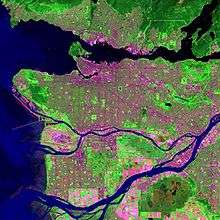Gastown
Gastown is the original settlement that became the core of the creation of Vancouver, British Columbia, Canada. Currently, it is a national historic site and a neighbourhood in the northwest end of Downtown Eastside, adjacent to Downtown Vancouver.[1][2]
Gastown | |
|---|---|
Neighbourhood | |
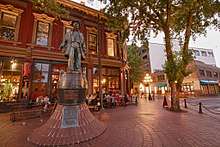 View of Gastown from Maple Tree Square | |
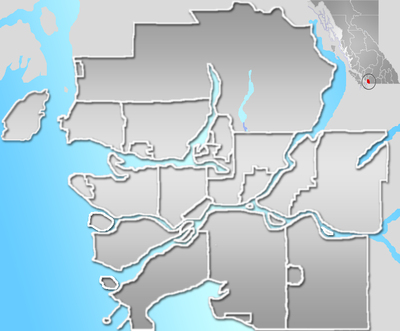 Gastown Location in Metro Vancouver | |
| Coordinates: 49.284688°N 123.110953°W | |
| Country | |
| Province | British Columbia |
| City | Vancouver |
Its historical boundaries were the waterfront (now Water Street and the CPR tracks), Carrall Street, Hastings Street, and Cambie Street, which were the borders of the 1870 townsite survey, the proper name and postal address of which was Granville, B.I. ("Burrard Inlet"). The official boundary does not include most of Hastings Street except for the Woodward's and Dominion Buildings, and stretches east past Columbia St., to the laneway running parallel to the west side of Main Street.
History
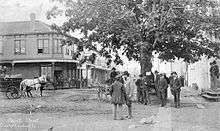
| Part of the series on | ||||||||||||||||||||
| History of Vancouver | ||||||||||||||||||||
|---|---|---|---|---|---|---|---|---|---|---|---|---|---|---|---|---|---|---|---|---|
| History | ||||||||||||||||||||
|
||||||||||||||||||||
| Events | ||||||||||||||||||||
|
||||||||||||||||||||
| Timeline of Vancouver history | ||||||||||||||||||||
Gastown was Vancouver's first neighbourhood and is named for "Gassy" Jack Deighton, a Yorkshire seaman, steamboat captain and barkeep who arrived in 1867 to open the area's first saloon. He was famous for his habit of talking at length (or "gassing") and the area around his saloon came to be known as "Gassy's town," a nickname that evolved to "Gastown."[3] The town soon prospered as the site of Hastings Mill sawmill, seaport, and quickly became a general centre of trade and commerce on Burrard Inlet as well as a rough-and-rowdy resort for off-work loggers and fishermen as well as the crews and captains of the many sailing ships which came to Gastown or Moodyville, on the north side of the inlet (which was a dry town) to load logs and timber. The Canadian Pacific Railway terminated on piles on the shore parallel to Water Street in 1886. From this the area became a hive of warehouses. Carrall Street was particularly swampy owing to it being low ground between False Creek and Burrard Inlet. Bridges overcame this obstacle, and the low ground and beach was slowly filled in with refuse.
In 1886 the town was incorporated as the City of Vancouver. It fell victim to the Great Vancouver Fire that same year, losing all but two of its buildings, but the area was completely rebuilt and continued to thrive. Hastings and Main was the traditional centre of town, and the foreshore became an important staging area with the North and West Vancouver Ferries, and Union Steamships all having docks there. Evans, Coleman, Evans, a longtime merchandiser, had a warehouse; Fleck Brothers, and Koret distributors also had buildings. Department stores such as Spencer's, Hudson's Bay Company warehouse, Woodward's, Fairbanks Morse, Army and Navy stores, and food retailers Malkins and Kelly Douglas traded and were based there.
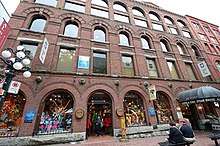
Gastown found new life as the centre of the city's wholesale produce distribution until the Great Depression in the 1930s. It was also the centre of the city's drinking life: there were 300 licensed establishments the twelve-block area of the former Granville. After the Depression Gastown was a largely forgotten neighbourhood of the larger city and fell into decline and disrepair as a continuation of the Skid Row area with cheap beer parlours, flophouse hotels, and loggers' hiring halls.
In the 1960s, citizens became concerned with preserving Gastown's distinctive and historic architecture, which like the nearby Chinatown and Strathcona was scheduled to be demolished to build a major freeway into the city's downtown. A campaign led by businesspeople and property owners, as well as the counterculture and associated political protestors gained traction to save Gastown. Henk F. Vanderhorst, a Dutch immigrant to Canadian citizen, opened the 'Exposition Gallery', an art gallery on Water Street which started, flourished and encouraged a flow of other fledgling business startups to boom in the Gastown core. His influence with the revitalization of Gastown was acknowledged in 1976 by being awarded 'The First Pioneer Citizen of Gastown' award by Mayor Art Phillips. "A key to the city". Vanderhorst's efforts, in part, pressured the civic, provincial and federal governments to declare Gastown a historical site, protecting its heritage buildings to this day.
A riot between the hippies and the police in 1971 over marijuana has gone into legend, the incident now made public on the Woodwards building, a throwback to the more serious Post office riot of 1938.
Gastown was designated a National Historic Site of Canada in 2009.[4]
Today
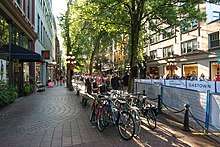
Gastown is a mix of "hip" contemporary fashion and interior furnishing boutiques, tourist-oriented businesses (generally restricted to Water Street), restaurants, nightclubs, poverty and newly upscale housing. In addition, there are law firms, architects and other professional offices, as well as computer and internet businesses, art galleries, music and art studios, tattoo parlours, and acting and film schools.
In February 2013, The Gastown Gazette began publishing local news and stories about the ongoing protests against gentrification in the Downtown Eastside and Gastown area of Vancouver. The community paper has since gathered provincial and national attention for reports on the neighborhood.[5]
Gastown has become a hub for technology and new media. It has attracted companies such as Zaui Software, Idea Rebel, MetroQuest, BootUp Labs Entrepreneurial Society, SEOinVancouver and MarketR.[6]
Popular annual events that take place on the cobblestone streets of Gastown include the Vancouver International Jazz Festival and the Global Relay Gastown Grand Prix international bicycle race.
In June 2004, Storyeum opened in Gastown. It was a lively theatrical 65-minute show that re-enacted the history of BC using eight sets that were all located below street level. Unfortunately, due to mounting debt, the attraction closed its doors in October 2006.
Gastown Steam Clock
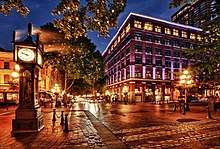
Gastown's most famous (though nowhere near oldest) landmark is the steam-powered clock on the corner of Cambie and Water Street. It was built in 1977 to cover a steam grate, part of Vancouver's distributed steam heating system, as a way to harness the steam and to prevent street people from sleeping on the spot in cold weather.[7] Its original design was faulty and it had to be powered by electricity after a breakdown. The steam mechanism was completely restored with the financial support of local businesses as it had become a major tourist attraction, and is promoted as a heritage feature although it is of modern invention.
The steam used is low pressure downtown-wide steam heating network (from a plant adjacent to the Georgia Viaduct) that powers a miniature steam engine in its base, in turn driving a chain lift. The chain lift moves steel balls upward, where they are unloaded and roll to a descending chain. The weight of the balls on the descending chain drives a conventional pendulum clock escapement, geared to the hands on the four faces. The steam also powers the clock's sound production, with whistles being used instead of bells to produce the Westminster "chime" and to signal the time.
In October 2014, the clock was temporarily removed for major repairs by its original builder, and was reinstalled January 2015.[8][9]
The clock appears on the cover of the Nickelback album Here and Now and is also featured in a scene from the 1991 Chuck Norris action film The Hitman.
Nightlife
Bars (a different licensing category in Vancouver) include 19 Below, The Cambie, 6 Acres, Chill Winston, Columbia Club, Lamplighter Public House, One Lounge, Revel, The Annex, and The Columbia. Mao Mao Bistro, a former club, has since been replaced by The Greedy Pig. The Town Pump, had been a live music venue since the hippie era of the 1960s. The Blarney Stone is one of Vancouver's Irish-style party houses.
References
- "Downtown Eastside Local Area Plan" (PDF). City of Vancouver. 15 March 2014. Retrieved 3 April 2019.
- "Vancouver Neighbourhoods Map". VanMap. City of Vancouver. Retrieved 3 April 2019.
- Kalman, Howard. Exploring Vancouver, University of British Columbia, 1974, page 5
- Bellett, Gerry. "Vancouver's Gastown designated national historic site". The Vancouver Sun. Canwest Publishing Inc. Archived from the original on 2009-07-17. Retrieved 1 January 2015.
- "Pidgin protests in Downtown Eastside concern activist funders". The Globe and Mail. 2013-04-29. Retrieved 2017-09-18.
- "Gastown Tech Cluster".
- Robertson, Merv (February 25, 1999). "Administrative Report: RTS MP/ 00474". Former Website of the City of Vancouver. City of Vancouver [B.C., Canada]. Retrieved 1 January 2015.
-
"Gastown Steam Clock undergoes repairs". City of Vancouver. City of Vancouver (B.C., Canada). 2014-10-08. Retrieved 1 January 2015.
The mechanical moving parts of the Steam Clock’s device for loading the metal balls have worn over the last 37 years and can no longer be reliably maintained. Mechanical failures have been a common occurrence in the past year, and the proposed repairs to the ball loading device will restore reliability to the Steam Clock while maintaining its historical integrity.
- Baker, Paula (2014-11-19). "Gastown landmark steam clock getting an overhaul". Global News. Shaw Media. Retrieved 1 January 2015.
External links
| Wikimedia Commons has media related to Gastown. |
| Wikivoyage has a travel guide for Gastown-Chinatown. |
- Official Gastown Community Website
- Gastown at Virtual Vancouver
- Global Relay Gastown Grand Prix
- Club Zone.com "Gastown Bars" page
- The Gastown Gazette, community newspaper
- Gastown page, Vancouver Then and Now website, comparisons of old photos with modern locations
Archival photos
- View of Gastown from offshore, 1884, prior to announcement of CPR terminus
- View of Gastown from offshore, 1886
- View of Alexander Street, Gastown c.1911
- View of Water Street from jct. Cordova Street, c.1890
- View of Water Street from Maple Tree Square, 1887 (Sunnyside Hotel at right)
- View of Cordova Street from above intersection of Carrall; July 1, 1890 Dominion Day celebrations
- View of Cordova Street from above intersection of Cambie; c.1900 when this was still the city's principal shopping district
